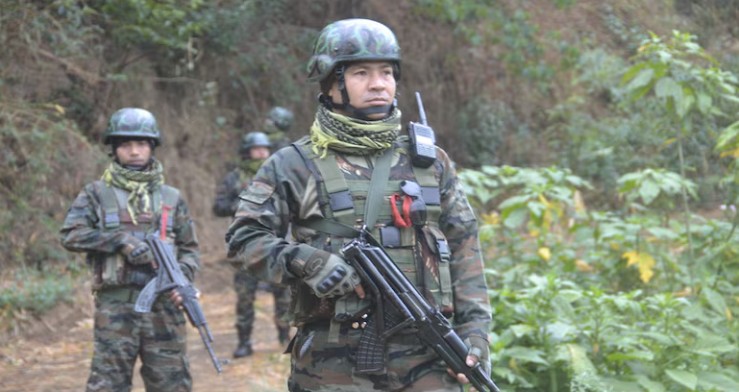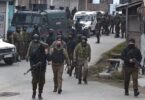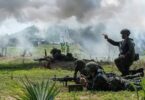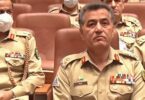Army and Assam Rifles launched a series of operations against Northeast terrorists’ groups located in Myanmar on the night of October 21 and 22, 2025. Contact established with terrorists at 6th Mile Camp village area in Namsai district of Arunachal Pradesh was followed by exchanges of fire between the two sides which lasted for several hours. Also part of this operation, was a well-coordinated cross-border drone strike launched against the National Socialist Council of Nagaland’s Khaplang Yung Aung group (NSCN-(K-YA)) camps inside Myanmar on the evening of October 19, targeting its top leadership. The drones specifically hit the camp of self-styled Major General Peyong Konyak, a senior NSCN (K-YA) commander believed to be the key mastermind behind the recent attack on an Assam Rifles company operating base (COB) in Changlang district of Arunachal Pradesh. Five terrorists, including three of Peyong’s personal bodyguards, were killed in the attack.
The drone strike was an added response to the military action on ground after a series of assaults by terrorists in the region. On October 16, suspected NSCN (K-YA) terrorists had attacked an Assam Rifles COB at Hedman, along the Indo-Myanmar border in Changlang.
In a separate incident, ULFA (I) cadres launched an attack on an Army base at Koomsang under Kakopathar police station in Assam’s Tinsukia district, injuring three Army personnel. The ULFA (I) terrorist were armed with under-barrel grenade launchers and automatic rifles during the assault.
On the next day, October 17, ULFA (I) terrorists attempted a similar strike on the Kakopathar Camp at Tinsukia district in eastern Assam. Alert troops retaliated decisively, inflicting casualties on the terrorist groups and apprehending an over ground worker (OGW) involved in the plot. In response, Assam Rifles intensified its operations, activating an extensive counter-insurgency grid supported by modern surveillance assets, drones, and intelligence-based hi-tech teams. The enhanced grid culminated in a successful ambush on October 21 at 6th Mile Camp and Lekang Khampti areas in Namsai district in South Arunachal Pradesh, resulting in the neutralisation of one ULFA (I) cadre and recovery of warlike stores.
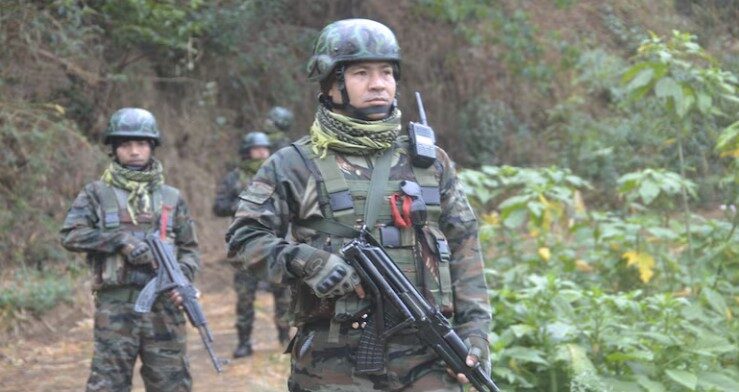
The search conducted in the areas resulted in the recovery of one dead body of a terrorist identified as Iwon Axom, a self-styled Sergeant Major of ULFA-I. One rifle, one rocket-propelled grenade (RPG) round, and three rucksacks were recovered along with the body of the militant from the spot. these rapid and precise actions not only foiled the nefarious designs of the terrorists but also re-established the moral ascendancy of the security forces across the region. With their networks disrupted and leadership under pressure the terrorists’ groups were reported to be on the run.
How come ULFA-I and NSCN(K) lying low in Myanmar for a long time attacked the Army and Assam Rifles barely a couple of months after Op Sindoor?
In view of Pakistan army chief Asim Munir’s recent threat conveyed after the extensive destruction caused by Indian Armed Forces on many terrorist and strategic assets in Pakistan within just 88 hours of Operation Sindoor in May 2025, that his next attack on Indian forces will be from the East, these attacks are most likely part of such a plan. With Munir having very limited manpower after the multiple bashings that Pak army has taken owing to the Afghan Taliban, Tehriq e Taliban Pakistan, the Pashtuns of Khyber Pakhtoonkhwa, armed Balochis from Balochistan and then Op Sindoor, the best way out at this time is to have the Inter-Services Intelligence (ISI) revive its contacts with India’s Northeast terrorist groups and use them again to attack Indian security forces.
It may be recalled that ISI has had a lot of contact with Northeast terrorists’ groups since the early 1990s when ISI present in great numbers in Bangladesh under BNP rule, made its maiden entry into India’s Northeast, thanks to the ULFA, which escaped to Bangladesh after President’s rule was imposed in Assam and the Indian Army was called out to deal with ULFA. As soon as Operation Bajrang was launched by the Army in Assam, ULFA in large numbers escaped to Bangladesh. This was at a time when Begum Khalida Zia heading the Bangladesh Nationalist Party (BNP) was in power and large numbers of ISI were posted in Bangladesh. Very soon after ULFA escaping to Bangladesh it came totally under ISI’s charge and not only facilitated the entry of ISI operatives into India’s NE region but also introduced them to the NSCN -Issac-Muivah (IM), Manipur’s Meitei groups – PLA, UNLF and some others as well as other insurgent groups around. Thereafter began much interaction in which ISI motivated and armed these groups to enhance their anti-India activities. In fact, it was at this stage that the Northeast groups progressed from being classic insurgents to terrorists. This author’s book Assam: Terrorism and the Demographic Challenge (2009, Centre for Land Warfare Studies and Knowledge World) elaborates on whatever has been mentioned in this article and more related issues.
The United Liberation Front of Asom (ULFA) founded in Assam in 1979 became a terrorist outfit carrying out sabotage and armed attacks, targeting security forces and critical infrastructure such as oil depots and gas pipelines. It got split in 2011, when many of its top leaders, including Chairman Arabinda Rajkhowa, expressed a willingness to engage in peace talks with the government without the precondition of sovereignty. This was rejected by the group's military leader, Paresh Baruah, who formed the ULFA-Independent (ULFA (I)) faction in 2012 to continue the armed struggle moving to Bhutan and then to Bangladesh and eventually into Myanmar’s Sagaing region. While the government has extended invitations for talks, Baruah's faction has consistently turned them down.
NSCN-K was formed on April 30, 1988, after a split in NSCN. Clan and tribal divisions among the major Naga groups (Konyak and Tangkhul) were the primary reason leading to the division. Khaplang was the founding ‘chairman’ of one of the two groups that emerged from the split; the other was headed by its late ‘president’ Isak Chisi Swu and T. Muivah, and came to be known as NSCN-IM. Under Khaplang’s leadership, the outfit emerged as the most active militant outfit in the region. After Khaplang’s death in June 2027, the group led by Yung Aung, NSCN-KYA has suffered losses on the ground. The NSCN faction under Thuingaleng Muivah made a mockery of a surrender in the late 1990s by surrendering without arms and continued its violence and illegal tax collection and running a parallel government, a reflection of the weakness of the central government in those days.
Since May 2025, ISI has been back in Bangladesh along with some American operatives of US’ well-known agency with fresh aims and plans of stoking mayhem in the Eastern and Northeastern parts of India and as per some indications, have been most likely involved in whatever happened in Bangladesh, Nepal and India’s Ladakh.
On October 26, 2025, The Sunday Guardian and some other agencies reported the “quiet death” of Terrence Arvelle “TJ” Jackson, a 50-year-old American national and senior U.S. Army officer, inside The Westin Hotel in Dhaka on August 31, 2025. “Jackson’s combination of rank, regional experience, and technical expertise—coupled with the absence of an autopsy and the speed of diplomatic repatriation—has deepened speculation over what he was doing in Dhaka” is a relevant comment. Shortly after Jackson’s death, a not yet named ISI agent was reported to have been found dead in Sheraton hotel in Dhaka.
While India has proved with Operation Sindoor to have established new and greatly higher normal in matters related to planning, preparing and implementing national security, it has impressed the world but has created much shock and jealousy for some. The effectiveness achieved must be maintained at all costs, if not heightened even further, to counter some very desperate plans that are being reportedly afoot.
The author a strategic affairs analyst and former spokesperson, Defence Ministry and Indian Army, can be contacted at wordsword02@gmail.com, https://www.linkedin.com/in/anil-bhat-70b94766/ and @ColAnilBhat8252
More on India’s North-East:
Bangladesh Makeover: https://www.thestrategicperspective.org/bangladesh-makeover/
Great Game Myanmar: https://www.thestrategicperspective.org/great-game-myanmar/
Unfinished Agenda of Mohd Yunus: https://www.thestrategicperspective.org/unfinished-agenda-of-mohd-yunus/
Mothballing Manipur: https://www.thestrategicperspective.org/mothballing-manipur/
India plays the Tibet card with telling effect: https://www.thestrategicperspective.org/india-plays-the-tibet-card-with-telling-effect/
The BanPak Affair: https://www.thestrategicperspective.org/the-banpak-affair/


